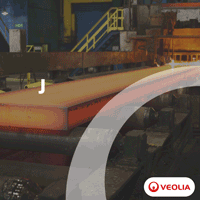IREPAS: Challenging Times in Global Longs Market Despite Demand Improvement
09/09/2014 - There has been a reasonable resumption of demand for long steel products in the North American and northern EU markets following the holiday period, IREAPS said in its September 2014 Short Range Outlook.
Overall, the supply-demand imbalance seems to have eased, particularly for semi-finished materials, as a result of some cuts in production.
Geopolitical conflict has caused business disruptions in the Black Sea region, Iraq and in Libya, affecting trading of steel billets and reinforcing bars in those areas. Demand remains at relatively good levels in the other MENA and African markets. The Southeast Asian market has improved in terms of demand as well. However, the market is slowing down in certain countries in South America.
The slowdown of steel consumption in China together with the increase in production is a major reason behind the supply-demand imbalance in the market. Supply at very competitive pricing from China is exerting a lot of pressure in certain markets around the world.
On the other hand, the difference in cost between scrap-based and iron ore-based steel production as well as ongoing cheap logistics costs are causing other imbalances in the marketplace.
Ferrous scrap prices have indicated upward movement in Asia and the US, while prices have just been indicating slight fluctuations in the Mediterranean and other regions after active purchases. The world market for scrap continues to see near-record consumption and has become more broad-based geographically.
Competition in the long steel products market is currently fierce amid strong pressure from Chinese suppliers. Profit margins are half of what they need to be for most players. On the other hand, the lack of sales to the Iraqi market has resulted in increased competition among Turkish rebar exporters.
Oversupply has become a constant feature of the global long steel products market and this situation is not expected to change. The cost disparity between blast furnace iron and ferrous scrap is very high and causes scrap buyers to be cautious. Scrap prices may ease due to the influence of iron ore prices and downward pressure from the euro/US dollar exchange rate. However, any significant scrap price reduction may also reduce collection activity.
The US market is driving consumption and optimism. The final decision in the US dumping investigation against reinforcing bar imports is expected this month and will certainly have an impact, if any different than the preliminary decision. Protectionist actions may become more widespread, which would definitely put pressure on prices in the international market and on margins. The attitude of the US DOC is unfortunately giving a bad example to all other markets, leading them to impose non-tariff barriers on imported goods without any solid basis.
The current market circumstances are very challenging, and any change will depend strongly on the situation between Ukraine and Russia and to a lesser extent on Iraq. The price and volume of Chinese steel exports will also influence the market pricing for both steel products and ferrous scrap.
This report from IREPAS’ Short Range Outlook: September 2014.
Geopolitical conflict has caused business disruptions in the Black Sea region, Iraq and in Libya, affecting trading of steel billets and reinforcing bars in those areas. Demand remains at relatively good levels in the other MENA and African markets. The Southeast Asian market has improved in terms of demand as well. However, the market is slowing down in certain countries in South America.
The slowdown of steel consumption in China together with the increase in production is a major reason behind the supply-demand imbalance in the market. Supply at very competitive pricing from China is exerting a lot of pressure in certain markets around the world.
On the other hand, the difference in cost between scrap-based and iron ore-based steel production as well as ongoing cheap logistics costs are causing other imbalances in the marketplace.
Ferrous scrap prices have indicated upward movement in Asia and the US, while prices have just been indicating slight fluctuations in the Mediterranean and other regions after active purchases. The world market for scrap continues to see near-record consumption and has become more broad-based geographically.
Competition in the long steel products market is currently fierce amid strong pressure from Chinese suppliers. Profit margins are half of what they need to be for most players. On the other hand, the lack of sales to the Iraqi market has resulted in increased competition among Turkish rebar exporters.
Oversupply has become a constant feature of the global long steel products market and this situation is not expected to change. The cost disparity between blast furnace iron and ferrous scrap is very high and causes scrap buyers to be cautious. Scrap prices may ease due to the influence of iron ore prices and downward pressure from the euro/US dollar exchange rate. However, any significant scrap price reduction may also reduce collection activity.
The US market is driving consumption and optimism. The final decision in the US dumping investigation against reinforcing bar imports is expected this month and will certainly have an impact, if any different than the preliminary decision. Protectionist actions may become more widespread, which would definitely put pressure on prices in the international market and on margins. The attitude of the US DOC is unfortunately giving a bad example to all other markets, leading them to impose non-tariff barriers on imported goods without any solid basis.
The current market circumstances are very challenging, and any change will depend strongly on the situation between Ukraine and Russia and to a lesser extent on Iraq. The price and volume of Chinese steel exports will also influence the market pricing for both steel products and ferrous scrap.
This report from IREPAS’ Short Range Outlook: September 2014.


.gif?lang=en-US&ext=.gif)
-(220-x-200-px)-(130-x-130-px)-(220-x-200-px).jpg?lang=en-US&ext=.jpg)
.gif?width=200&height=200&mediaprotectionhash=ddb07947ad3b4ab959a83714461eccd5c6895f370695eb035a9ff7aa736f8ad9&ext=.gif)



.png?lang=en-US&ext=.png)